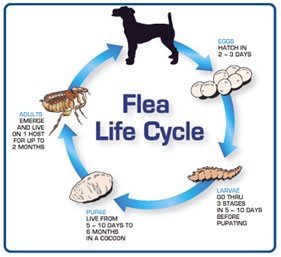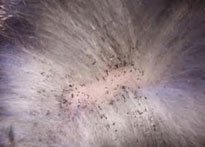Fleas
Fleas are the most common external parasite of companion animals. They live by consuming the blood of their hosts. Adults fleas are about 3 mm long and brown in color. Their bodies are flattened sideways which enables them to easily move through their host’s fur and they have strong claws that prevent them from being dislodged. They also have hind legs that are adapted for jumping which allows them to leap up to 50 times their body length. Stray cats and dogs, raccoons and rabbits can carry flea eggs into your yard. Fleas can survive in lows as cold as 28F and highs up to 95F.

Many pet owners are surprised to learn their pet has fleas because they have not noticed them. In many cases we do not see the fleas until a thorough exam is performed. This is because many animals lick, groom and chew after being bitten by a flea, causing the flea to either jump off, or get swallowed by the pet.
Fleas are dangerous because they can cause a number of health problems with our pets including:
• Anemia (low red blood cell count in the body) due to blood loss. This anemia can be life threatening in smaller or very young animals and even
in larger animals, if there is a heavy flea infestation present.
• Severe itching which leads to hair loss and secondary skin infections. In fact, some animals are allergic to flea bites and they will develop a condition called flea allergy
dermatitis. This is commonly found in dogs and cats and can be very uncomfortable and requires medical treatment to resolve.
• A bacterial infection called Bartonella that is transmitted when they bite. This not only causes health issues in
dogs and cats but can affect people as well.
• A type of intestinal tapeworm called Dipylidium caninum can be transmitted if a dog or cat ingests the flea. The flea body contains an immature form of the parasite and if ingested will mature
in the intestine of the dog or cat and compete for the nutrients of the pet.

The flea life cycle consists of egg, larval, pupal, and adult stages.
1) Eggs are laid in the hair coat and fall off your pet into your home.
2) Larvae hatch from the eggs and develop in a pet’s environment by feeding on adult flea feces
(i.e. digested blood) that falls out of the hair coat of the pet.
3) Larvae eventually spin cocoons, often within carpet fibers, for pupation. The pupae in the cocoons are resistant to freezing, drying, and insecticides, and can lie dormant
for many months!
4) New fleas develop from pupae and can begin feeding within hours of finding a dog or cat. The entire flea life cycle can be completed in as little as three weeks.
We diagnose a flea infestation by either seeing adult fleas or by using a flea comb and pulling flea “dirt”. Flea dirt is actually flea fecal material. Fleas take blood meals of your pet and their fecal material contains blood. If we rinse flea dirt with a small amount of water on a white paper towel, the spots will turn a rusty brown.

Fleas are very difficult problem to solve and certainly prevention is much less expensive and stressful than treatment. One female adult flea produces 40 to 50 eggs per day. You can see how quickly this can get out of control. The other issue is that only about 1% of the population of fleas, eggs and larvae live on your pet and the other 99% live in the environment. That is to say, they exist in your homes carpet, bedding, couches, clothing, etc. This makes treatment very frustrating.
Treatment includes treating EVERY pet in the house (dogs and cats) for ideally 6 months, at a minimum of 3 months, with an oral or topical flea and tick medication. Products we carry for dogs include: Frontline Gold topical, Nexgard oral and Bravecto oral medications. Products we carry for cats include: Frontline Gold topical, Revolution topical and Bravecto topical.
Treatment also includes aggressively treating the environment. This may take multiple treatments and includes: spot sprays (i.e. Knockout) and room foggers (i.e. Adams or Raid) and washing all bedding in areas where the pet sleeps. We have Knockout
spray and Adams room fogger products available.
It is also recommended to vacuum all floors multiple times and then replace the bag or wash out the vacuum canister thoroughly. Remember, fleas thrive particularly well in the well-regulated temperatures
in the home and love to develop in carpeting and the cracks between the boards of hard wood floors.
It may take multiple repeated treatments to eliminate the fleas and their entire life cycle of larvae and eggs. By the time you see active fleas
on your pet they have been living in your home for at least 2 months.
Of course, after this infestation has been resolved, we recommend monthly flea/tick preventative for all your pets.
Ticks
Ticks are external parasites that feed on the blood of their hosts. They are attracted to motion, body heat, and carbon dioxide exhaled by mammals making people, dogs, cats and other mammals their ideal hosts.
The two most common ticks we have in this area are the American Dog tick and the Deer tick. They are slightly different in appearance and the Deer ticks are smaller than the Dog ticks.
Deer ticks are the ticks responsible for transmitting diseases in our area.

Deer ticks attach to the host to take a blood meal and in the process of taking this meal they can transmit bacterial diseases to the host. The nymph Deer ticks are almost microscopic in size so you may never know your dog was ever bitten by one.
Anaplasmosis and Lyme disease are the two most common tick diseases that we encounter in our area. These tick diseases cause potentially life-threatening symptoms and cause your pet pain and suffering.
Some symptoms of Lyme disease include:
• Fever
• Lethargy
• Stiffness and reluctance to move
• Swollen joints
• Shifting leg lameness
• Enlarged lymph nodes
• Rarely neurologic signs are noted
• The most serious potential
consequence of Lyme disease is a type of kidney damage that leads to acute and progressive kidney failure.
Some symptoms of Anaplasmosis include:
• Fever
• Lethargy
• Stiffness and reluctance to move
• Swollen joints
• Shifting leg lameness
• Enlarged lymph nodes
• Signs of uncontrolled internal bleeding, such as bloody nose,
bruising, and dark blood in the stool.
We recommend protecting your pet in multiple ways:
• TESTING FOR EXPOSURE: Screening dogs yearly for exposure to Lyme and Anaplasmosis organisms is important. We do this by using a simple in-house combination heartworm/tick disease screening
blood test.
• VACCINATION: Vaccination against Lyme disease to allow your pet to develop immunity against the bacteria responsible for causing this disease. This vaccine requires 2 initial boosters 2 to 3 weeks apart and is then repeated annually.
• FLEA/TICK PREVENTATIVES: To reduce the risk of transmission of other tick diseases to your pet. We have both topical and oral flea and tick preventative products available.
